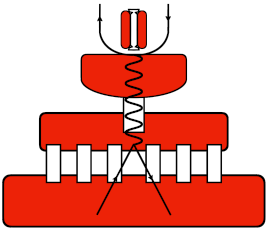Speaker
Description
We are searching for the decay $K_L\to \pi^0\nu\bar{\nu}$ at the KOTO experiment in J-PARC. The standard model prediction for the branching ratio (BR) is $(3.0\pm0.3)\times10^{-11}$. In 2018 KOTO achieved the best upper limit to date of BR$ < 3.0\times10^{-9} (90\%\,\mbox{C.L.})$, improving by an oder of magnitude the previous limit by KEK E391a. The experimental signature is two photons from the $\pi^0$. To detect this simple signature, the KOTO detector consists of a cesium iodide (CsI) calorimeter and hermetical veto counters in a high vacuum environment. The calorimeter is made of 50-cm-long CsI crystals stacked in a cylinder of 1.9 m diameter. Each crystal is read out with a PMT on its back side.
For the next step, we have updated the calorimeter to reduce one of the major backgrounds caused by a neutron generating two clusters in the calorimeter. Because neutrons tend to generate scintillation showers deeper in the calorimeter, the updated calorimeter reads out the scintillation lights from the front side and the back side of the crystals---the time difference between the front and back readout helps in separating photons from neutrons.
To implement a double side readout, we have installed 4000 silicon photomultipliers~(SiPMs) on the front surface of crystals in addition to PMTs on the back surface. The construction was carried out on-site without disassembling the stack of crystals in the detector from September to December 2018. I will report the special techniques we used to glue the SiPMs on the CsI crystals to keep UV transparency, mechanical robustness, radiation tolerance, and vacuum resistance.




